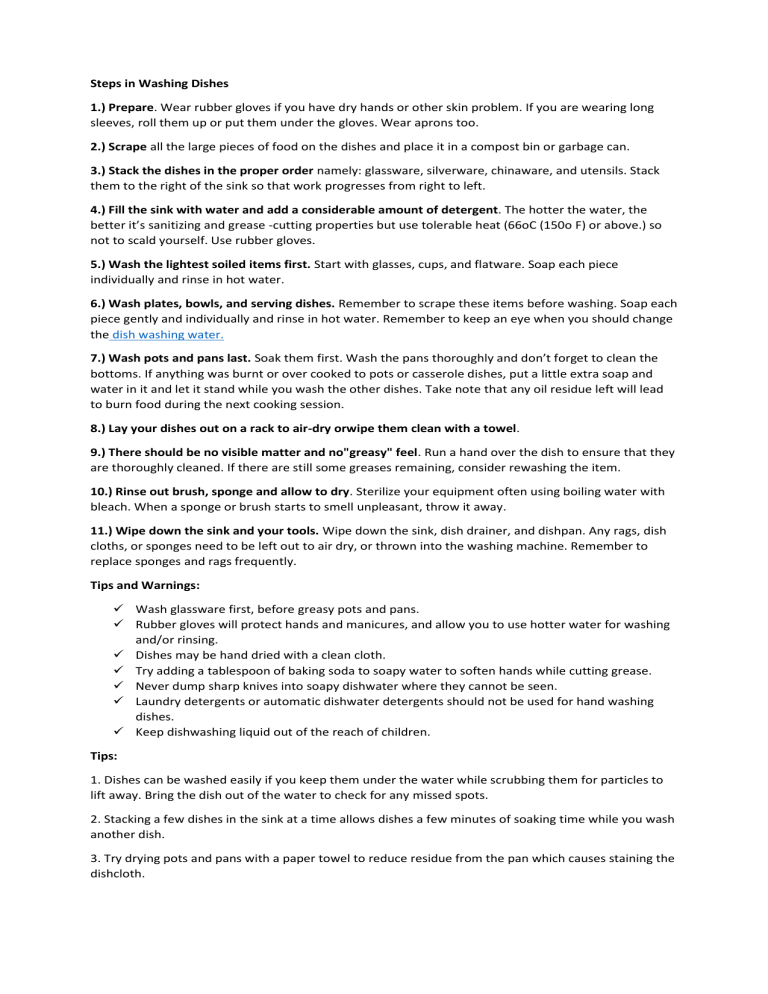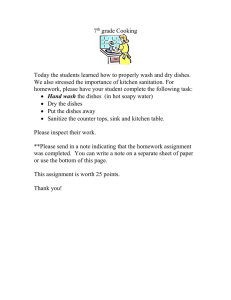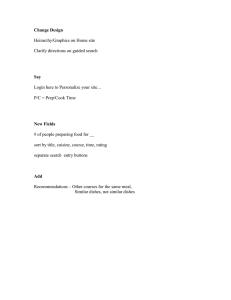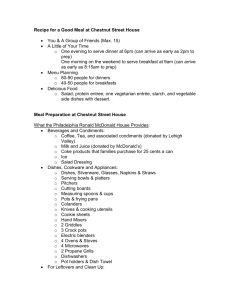
Steps in Washing Dishes 1.) Prepare. Wear rubber gloves if you have dry hands or other skin problem. If you are wearing long sleeves, roll them up or put them under the gloves. Wear aprons too. 2.) Scrape all the large pieces of food on the dishes and place it in a compost bin or garbage can. 3.) Stack the dishes in the proper order namely: glassware, silverware, chinaware, and utensils. Stack them to the right of the sink so that work progresses from right to left. 4.) Fill the sink with water and add a considerable amount of detergent. The hotter the water, the better it’s sanitizing and grease -cutting properties but use tolerable heat (66oC (150o F) or above.) so not to scald yourself. Use rubber gloves. 5.) Wash the lightest soiled items first. Start with glasses, cups, and flatware. Soap each piece individually and rinse in hot water. 6.) Wash plates, bowls, and serving dishes. Remember to scrape these items before washing. Soap each piece gently and individually and rinse in hot water. Remember to keep an eye when you should change the dish washing water. 7.) Wash pots and pans last. Soak them first. Wash the pans thoroughly and don’t forget to clean the bottoms. If anything was burnt or over cooked to pots or casserole dishes, put a little extra soap and water in it and let it stand while you wash the other dishes. Take note that any oil residue left will lead to burn food during the next cooking session. 8.) Lay your dishes out on a rack to air-dry orwipe them clean with a towel. 9.) There should be no visible matter and no"greasy" feel. Run a hand over the dish to ensure that they are thoroughly cleaned. If there are still some greases remaining, consider rewashing the item. 10.) Rinse out brush, sponge and allow to dry. Sterilize your equipment often using boiling water with bleach. When a sponge or brush starts to smell unpleasant, throw it away. 11.) Wipe down the sink and your tools. Wipe down the sink, dish drainer, and dishpan. Any rags, dish cloths, or sponges need to be left out to air dry, or thrown into the washing machine. Remember to replace sponges and rags frequently. Tips and Warnings: Wash glassware first, before greasy pots and pans. Rubber gloves will protect hands and manicures, and allow you to use hotter water for washing and/or rinsing. Dishes may be hand dried with a clean cloth. Try adding a tablespoon of baking soda to soapy water to soften hands while cutting grease. Never dump sharp knives into soapy dishwater where they cannot be seen. Laundry detergents or automatic dishwater detergents should not be used for hand washing dishes. Keep dishwashing liquid out of the reach of children. Tips: 1. Dishes can be washed easily if you keep them under the water while scrubbing them for particles to lift away. Bring the dish out of the water to check for any missed spots. 2. Stacking a few dishes in the sink at a time allows dishes a few minutes of soaking time while you wash another dish. 3. Try drying pots and pans with a paper towel to reduce residue from the pan which causes staining the dishcloth. 4. Don’t soak aluminum while dishwashing for it may cause darkening. Dish washing silverware can be tricky. Use a lint free cloth for drying silverware.



